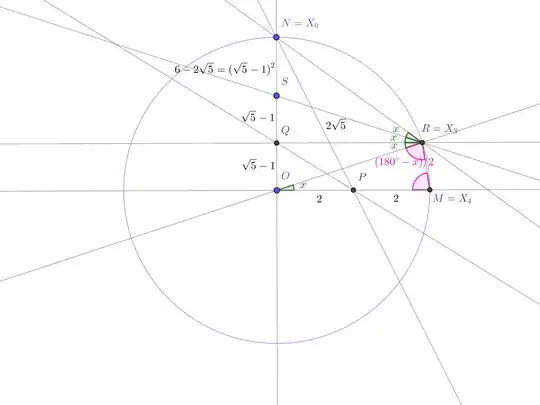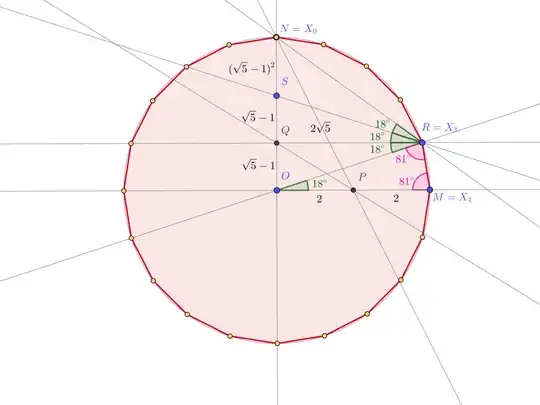Here is a solution which tries to not use the algebraic knowledge of some trigonometric function (sine, cosine, tangent) of the angle of $36^\circ$ or some related angle (half or double of it). However, since there are "only a few" angles in the picture which are in measure a rational multiple of $\pi$, mainly those in $R$, we still need to involve some algebraic part.
The idea is to show that the points $N,R,M$ from the OP are among the vertices of the $20$-gon. I will also use for them alternative notations $X_0$, $X_3$, and respectively $X_4$. To start with, let $S$ be the reflection of $O$ w.r.t. $Q$, so $OQ=QS$. I will work with a figure where the radius of the circle is
$$
4 = OM=ON\ .
$$
Then $PN=\sqrt{2^2+4^2}=2\sqrt 5$, and in $\Delta NOP$ the angle bisector theorem gives $OQ:QN=2:2\sqrt 5$, so $\displaystyle\frac{OQ}4=\frac{OQ}{OQ+QN}=\frac2{2\sqrt 5+2}=\frac1{\sqrt 5+1}$, so $\displaystyle OQ=\frac 4{\sqrt 5+1}=\sqrt 5-1$. Some further computations are:
$$
\begin{aligned}
QS &= OQ=\sqrt 5-1\ ,\\
SN &= ON-2OQ=6-\sqrt 5=(\sqrt 5-1)^2\ ,\\
QR^2 &=OR^2-OQ^2=16-(5-2\sqrt 5+1)=10+2\sqrt 5=2\sqrt 5(\sqrt 5+1)\ ,\\
NR^2 &= QR^2+QN^2=(10+2\sqrt 5) + (5-\sqrt 5)^2=40-8\sqrt 5=8\sqrt 5(\sqrt 5-1)\ ,\text{ so}\\
\frac{NR^2}{QR^2}
&
= \frac{8\sqrt 5(\sqrt 5-1)}{2\sqrt 5(\sqrt 5+1)}
= \frac{4(\sqrt 5-1)}{(\sqrt 5+1)}
=(\sqrt 5-1)^2 =\left(\frac{NS}{SQ}\right)^2\ .
\end{aligned}
$$
The reciprocal of the angle bisector theorem (its usage here being the idea of this proof), insures now that the line $RS$ bisects the angle in $R$ in $\Delta QRN$. Let $x$ be the measure of $\widehat{ROM}$. Then we have the following situation with further angles computed in terms of $x$, using parallelism and an isosceles triangle:

We obtain an equation involving $x$ from
$$
3x +\frac 12(180^\circ-x)=\widehat{NRM}=\frac 12\cdot (360^\circ-\overset\frown {MN})=\frac 12\cdot 270^\circ\ .
$$
We double, and solving for $x$ in $6x+(180^\circ-x)=270^\circ$, we get
$$
\color{blue}{\boxed{
\qquad
\begin{aligned}
x &=\frac 15\cdot90^\circ=18^\circ\ ,\\
\widehat {QRN}&=2x =36^\circ \ .
\end{aligned}
\qquad}}
$$
$\square$
We are done, but it may be a good impression to also see the $20$-gon in the picture...



